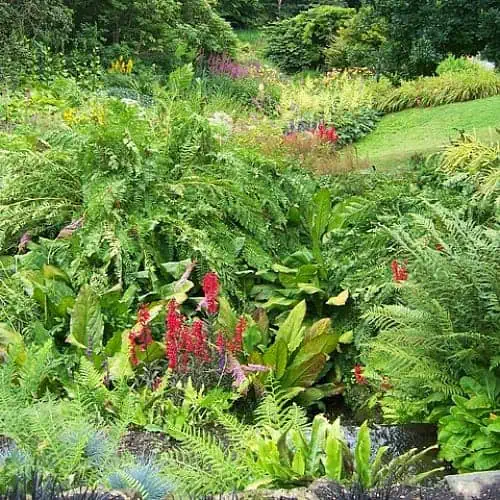
Bogs are a type of wetland composed of water and decaying organic matter. Plant species naturally found in bogs are generally tolerant of acidic, low oxygen and low nutrient environments, typically with a pH ranging from around 3.3 to 5.5, but some transitional bogs may have a pH as high as 6. They typically have spongy, acidic peat soils that never fully drain and are filled exclusively by precipitation rather than via groundwater.
To create your own bog garden, you can easily work with an existing waterlogged area on your property or around a garden pond. You can also dig out a shallow deposit and start a new bog garden, or easily create a small container garden. A common feature of bog garden plants is they must remain in moist, peaty soil or be submerged in shallow water. Regular watering or even an irrigation system during dry periods is necessary to keep a bog garden thriving.
It can be fun for the home gardener to grow their own plants that make it onto the dinner table. Usually, when we think of growing food at home, we think of common crop vegetables and fruits, but the wetland gardener can grow some unique edible plants of their own. Read on for some examples!
6 Bog Plants That Are Edible
1) Water chestnuts (Eleocharis dulcis)

Water chestnut plants are aquatic perennial sedges (family Cyperaceae) that thrive in acidic, low nutrient environments – perfect for bogs! Despite the name, water chestnuts are tuber vegetables, not nuts. The edible bulbotubers can be enjoyed raw or cooked, and they are unique because they maintain their crunchy white flesh even after cooking due to the composition of their cell walls, which are strengthened by phenolic compounds.
These plants originate in tropical climates and require a location with a long, warm growing season (approximately 7 months out of the year). They grow best in USDA zones 9-12. They are grown by planting the bulbs 2 in or 5 cm deep in the soil, and covered with up to 10 cm of water. Throughout the season, the stems can grow up to 3 feet tall. In the fall, when the stems turn brown it means the bulbs are will be dark brown, mature, and ready for harvesting.
If you are located in North America, Eleocharis dulcis, which is also called the Chinese water chestnut, should not be confused with the European water chestnut, Trapa natans, which is invasive in your area. Another important distinguishing characteristic is that while Trapa natans seeds are edible, the plant can be toxic if consumed.
2) Cranberries (Vaccinium subgenus oxycoccus and Vaccinium macrocarpon)
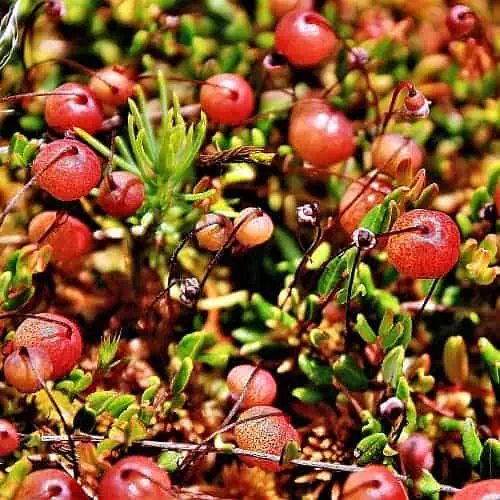
Cranberries are perennial evergreen shrubs that grow naturally in peatlands, deposits formed by organic matter and water. The most common, commercially grown type of cranberry is also one of the few fruits native to the U.S. (Vaccinium macrocarpon). There are also species native to Europe (Vaccinium oxycoccos). Cranberries should not be confused with cranberry-bush, which is another shrub in the genus Viburnum and is not a true cranberry.
Cranberries grow in USDA zones 4-7. Cranberry seedlings can be planted in a raised or sunken bed of acidic soil, ideally pH 4-5.5. It is recommended to test soil before planting, and to fertilize a few times until mid or late summer for the first few years. Cranberries should be watered regularly and soil kept moist but not waterlogged. The shrub grows low to the ground but creeps up to 7 feet/2 m in length. It produces pink flowers followed by the easily recognizable bright red fruit. Berries ripen and are ready for harvesting late in the year, often September to October which is why they are well known as a winter fruit and popular in holiday recipes.
Cranberries rely on bees for pollination so they can also make a bee-friendly addition to a bog garden! These plants can live for many years and in terms of maintenance, it is recommended to top off with a layer of sand every couple of years to encourage acidic conditions and continued growth.
3) Watercress (Nasturtium officinale)
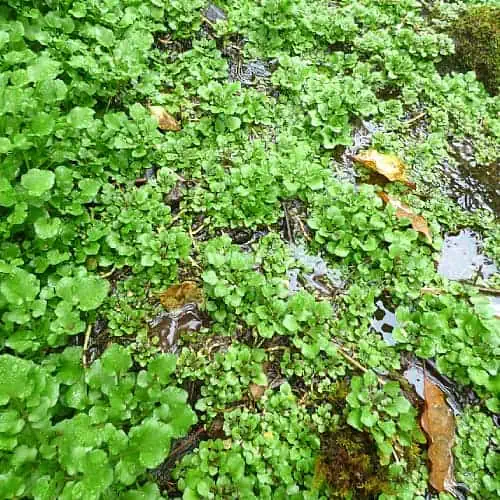
Watercress is a floating aquatic perennial in the family Brassicaceae, which contains cabbages and mustards. It is prized as a nutritious, leafy green vegetable with a peppery flavor. The seeds can also be used as a mustard substitute. Though watercress typically does best in a pH no lower than 6, it may survive in some transitional bog gardens.
Watercress can be planted by seed or cuttings. Plant in soil that is submerged 15-20 cm. It naturally grows in slow-moving water, so it makes a good addition to a home pond but it can even be grown in a container that retains water. It is hardy and can grow in USDA zones 3-11. Watercress does best when provided full sunlight, but it is also tolerant of cooler weather.
Watercress grows 2- to 4-inch-long leaves which cluster in groups of 3 to 9. The leaves are tastier early in the season, as the flavor changes during the blooming period. The leaves can be harvested only a few weeks after planting, and most plants can be harvested multiple times in a season. Watercress leaves grow back quickly after cutting and its rapid growth rate makes it potentially invasive outside of its native range.
4) Bog Labrador Tea (Ledum groenlandicum)
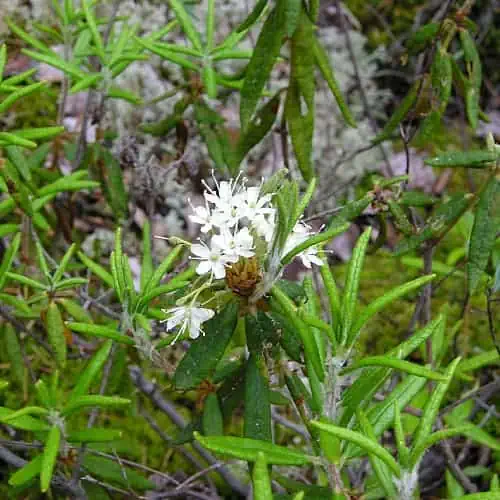
For tea lovers interested in growing their own herbal tea, bog Labrador tea can be a beneficial choice if used properly. It is a perennial shrub in the Heath family (Ericaceae). Historically, it was a popular drink and medicine used by Native American tribes before being introduced to European settlers and spreading to other cultures. It has many known uses, including chewing the leaves and brewing the leaves or flowers for various medicinal purposes.
In very high concentrations, bog Labrador tea can be toxic so it is very important to make a weak tea and avoid consuming large amounts. It is also recommended to steep the leaves rather than boil them, and remove them before drinking. It can be toxic to livestock, so it is important to prevent access to it if that might be a concern.
Labrador tea can be planted by seed or root propagation. Typical of a bog plant, it requires moist soil and can tolerate acidic conditions. It is slow-growing and it only grows to about 3 feet/1 m tall on average. It has evergreen, leathery leaves which can be harvested for use all year, and its small white flowers bloom from May to July. It makes another nice addition to a pollinator garden because it provides food for native insects such as bumblebees and butterflies.
5) Water Mint (Mentha aquatica)

Water mint, of the mint family Lamiaceae, is a great multipurpose addition to a garden for mint lovers. The leaves can be dried and brewed into an herbal tea. The leaves are also edible raw or cooked, but they have a very intense flavor that can be too strong for some, so using the oil for flavoring in cooking might be a better option. If you have other mint plants, it is known to hybridize easily with other mints, including spearmint to produce peppermint.
Grow water mint easily from seed or by transplanting a potted plant. It does best in full or partial shade and slightly acidic soil (pH 6-7), so would likely do best in a transitional bog environment with a slightly higher pH. It naturally grows along waterways and can be planted along the shore of a garden pond, although it can grow quickly and crowd out other plants.
For lower maintenance, it can also be grown in a container that retains moisture to help prevent spread. It has a few other benefits to your home garden – during the summer it blooms fragrant pink or purple flowers and its aroma naturally repels pests like mosquitoes and mice, while attracting valuable pollinators. In garden landscaping, it can help with erosion control.
6) Bog Blueberry (Vaccinium uliginosum)
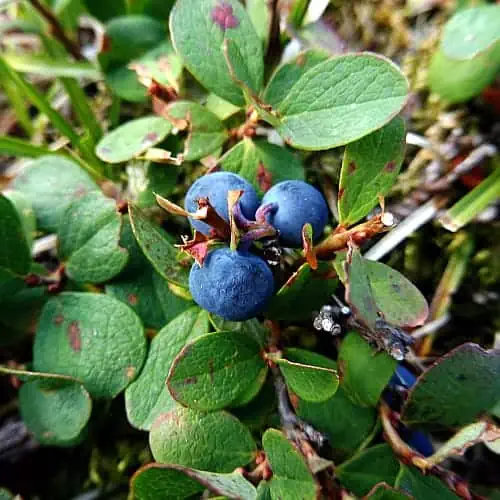
Commonly known as bog blueberry but also referred to as bog bilberry and alpine blueberry, this plant absolutely thrives in acidic conditions! As its name implies, bog blueberry is found growing naturally almost exclusively in acidic bog environments, though at times can be found in rocky environments like freshwater shorelines and acidic rockpools.
As a true blueberry, this plant is fully edible. The sweet berries can be eaten raw or cooked into pies, jams, or just about anything else you can conceive of, and the leaves can be steeped into a fresh and aromatic tea. Additionally, wildlife like songbirds, game birds like grouse, deer (including moose, if you have them!), squirrels, and many others feed on both ripe and unripe berries. These bushy blueberries also provide valuable cover to smaller wildlife from predators, heat, and to nest or rest. The foliage is green to green tinged with red, making it an attractive plant for bog gardens.
Bog blueberry can be found natively throughout the northern US, as well as Canada and Greenland. It can also be found in Japan and portions of Europe, where it was likely introduced but isn’t considered invasive. It thrives in naturally damp, cooler locations but does well in any bog that is on the cooler side with a pH as low as 3.5 or as high as 6.2, preferring USDA hardiness zones 2 through 6.
Able to reach up to 30 cm (11.8 in.) in height, bog blueberry can spread to form dense clumps but does so slowly, so you can trim it or dig it up to control this growth without too much issue, if desired. To plant, place rooted cuttings or seeds in acidic, moist soil in the fall, as this season provides ample moisture for them and having a dormancy period over winter will trigger greater growth in the spring. Seeds require winter stratification to scratch the seeds and stress them for spring growth, as well. If you can’t find bog blueberry for purchase, a very similar species that grows to the same size and is found in the same habitats and hardiness zones is the dwarf blueberry, Vaccinium caespitosum.

